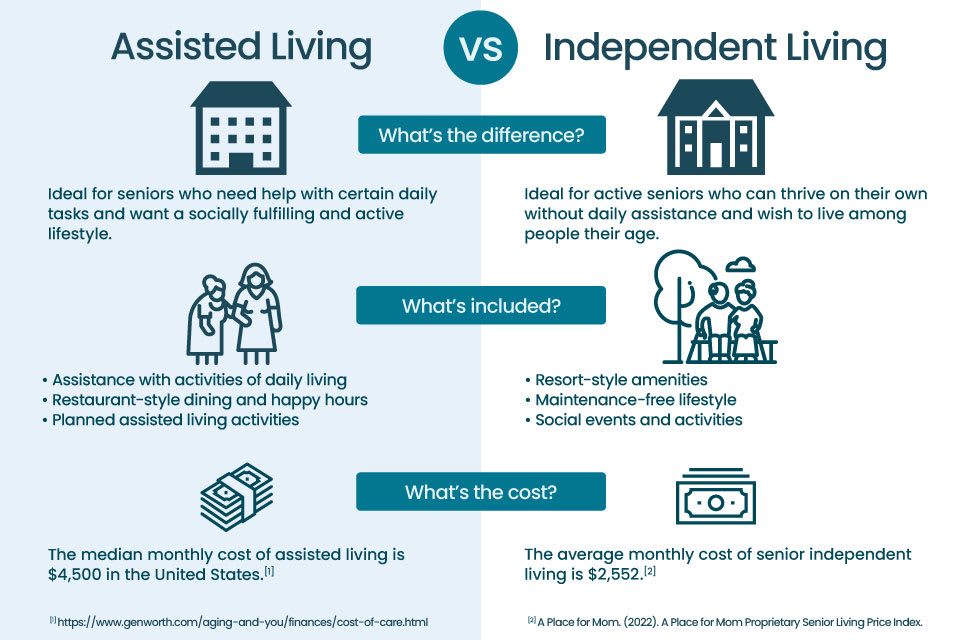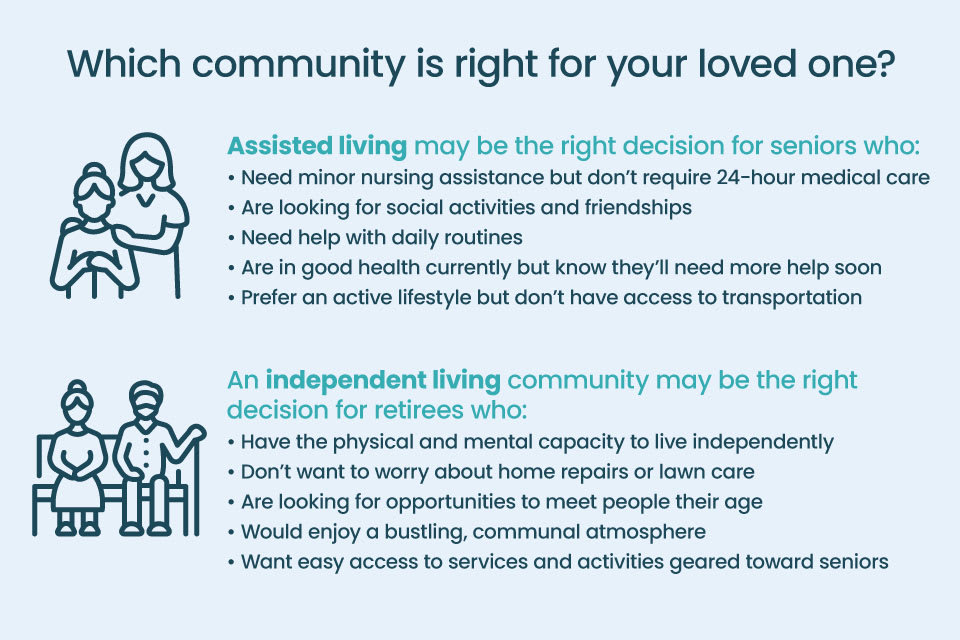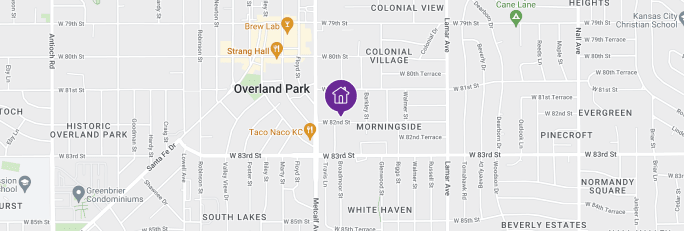Make the best senior care decision

Assisted Living vs. Independent Living: What's the Difference?

For retirees considering senior living options, it’s essential to find a good balance of independence, safety, and comfort. While staying in your longtime house is familiar and may feel like the ideal scenario, being at home alone can also be isolating and unstimulating. Homeownership often puts extra strain on seniors who have to keep up with regular maintenance and complete endless household chores. Health issues can make those responsibilities even more difficult.
Key Takeaways
- Independent living and assisted living communities offer different services. Assisted living provides help with activities of daily living, while independent living is for seniors who don’t need everyday support.
- Determine your loved one's social desires and medical needs. Understanding your loved one's needs will help you determine which type of care is the best fit.
- Cost depends on a variety of factors. Assisted living is generally more expensive, but location and the level of care needed play a role.
- Determine which options fits your unique situation. Use our free assessment to find care options that meet your needs and budget.
Though it may seem like a daunting change, moving into a retirement community can actually allow retirees to take advantage of a newfound freedom. Whether you wish to remain as independent as possible or you’re ready to seek assistance with daily living routines, there’s a senior community out there for you. But which type of environment is the best fit?
Explore the differences between assisted and independent living communities, discover their services and amenities, and understand key pricing details so you can one day move in with confidence.
What is the difference between assisted living and independent living?

Independent and assisted living communities both offer thoughtfully designed housing, senior-friendly amenities, daily meal plans, and exciting social activities. But there is one major difference between these senior living options: Assisted living provides help with activities of daily living (ADLs) like bathing and dressing, while independent living is for older adults who can complete daily tasks without assistance. Both communities cater to residents’ individual needs in unique ways.
Assisted living communities
Assisted living communities provide long-term housing and personalized health care services for seniors. Unlike those in independent living, assisted living services are for residents who require some additional support like medication management, help with personal hygiene tasks, and mobility assistance. Today, there are more than 810,000 Americans residing in assisted living communities who enjoy senior-focused benefits and amenities.
Assisted living communities provide:
- Apartment-style living
- Assistance with ADLs like bathing, grooming, and eating
- Housekeeping and laundry services
- Restaurant-style dining, daily snacks, and happy hours
- Event calendars of assisted living activitiesthat are developed based on residents’ interests and passions, including day trips to explore local community offerings like dining and entertainment
- Local transportation that allows residents to run errands, shop for groceries, or attend off-site medical appointments
Assisted living communities usually have certain health standards for admitting new residents to make sure that a person’s medical needs are within the community’s abilities. For example, seniors who require a high level of medical attention including 24-hour care may need a different type of living arrangement, such as a nursing home.
Sometimes people use similar terms to refer to the various types of senior living, which can be confusing. The terms “assistance,” “assisted,” or “facility” are a good indication that the community offers minor medical assistance but not full-time care. Other terms people use to refer to assisted living communities include:
- Assisted living facility or assisted living residence
- Adult congregate care
- Residential care facility
Independent living communities
Think of an independent living community as an age-restricted (typically 55+) apartment complex. Independent living communities usually feature organized activities, meal services, and transportation. While there may be overlap between independent living and assisted living communities in terms of amenities and minor care services offered, independent living usually means that residents are self-sufficient and don’t need hands-on care.
Independent living communities offer:
- Community involvement
- A continued sense of self
- Amenity-filled, maintenance-free living
- On- and off-site activities like yoga, gardening, game nights, and devotional services
- Basic services like meals, laundry, housekeeping, and transportation
You might hear people refer to independent living in different ways, emphasizing the vibrant and active senior living lifestyle found in these communities. Other common terms include:
- Retirement community or retirement home
- Independent senior living community or active senior community
- Active adult retirement community

Get a tailored list of senior living options.
Our free tool can provides independent or assisted living options that fit your unique situation.
How much do independent and assisted living communities cost?
The median monthly cost of assisted living is $4,500 in the United States, according to Genworth’s 2021 Cost of Care Survey,[01] while the average monthly cost of senior independent living is $2,552.[02]
It’s important to ask each community about their individual costs and services, as it’s not uncommon for costs to fluctuate annually or monthly. Assisted and independent living costs depend on many factors, including:
- Apartment size and style. Anticipate price differences when selecting from different floor plans, as communities may offer a selection between studios, one- or two-bedroom apartments, and private or shared rooms.
- Types of services needed. Some services may only be available as add-ons to the flat rate, like charging for transportation services, medication management, or guest meals. Concierge and guest services may also be included at some communities at an additional rate.
- Level of luxury offered. Some communities feature elite services like on-site personal trainers, professional chefs, or amenities like heated pools or rooftop bars.
- Community location. Assisted living in the Northeast usually is more expensive than in the Midwest and Southeast.
Independent living vs. assisted living: Which community is right for you?

When deciding what community is right for you or a senior loved one, start by taking both social and medical needs into consideration. Do you need assistance with ADLs but want to remain as active as possible? If so, an assisted living community can meet both of those needs. Are you hoping to leave behind trivial chores and live among other adults with shared interests? Independent living has you covered. Once you identify what’s most important— whether food and fun or friendships and wellness — you can more easily discover which particular community will be the best lifestyle fit.
An assisted living community may be the right decision for seniors who:
- Need help with ADLs and minor nursing assistance but don’t require 24-hour medical care
- Are in good health currently but know they’ll need more help soon
- Are looking for social activities and new friendships
- Prefer an active lifestyle but don’t have access to transportation
An independent living community may be the right decision for retirees who:
- Have the physical and mental capacity to live independently
- Don’t want to worry about home repairs or lawn care
- Are looking for opportunities to meet people their age
- Would enjoy a bustling, communal atmosphere
- Want easy access to services and activities geared toward seniors

Senior living facilities near you
There are senior living facilities in your area
Ready to explore independent and assisted living options?
Understanding the difference between assisted living and independent living is essential to keeping seniors healthy, active, and safe. Whether you need daily support from assisted living caregivers or you’re eager for the freedom of independent living, there are communities across the country that offer top-notch services and amenities.
If you’re ready to explore independent living and assisted living communities near you, our Senior Living Advisors can help. From scheduling community tours to comparing services and amenities, we’re here to support you every step of the way.
Genworth. (2021). Genworth’s Cost of Care Survey.
A Place for Mom. (2022). A Place for Mom Proprietary Senior Living Price Index.
Senior Living Facilities Near Me
Find a senior living facility
There are <strong></strong> facilities near ,
View senior living facilities
The information contained in this article is for informational purposes only and is not intended to constitute medical, legal or financial advice or create a professional relationship between A Place for Mom and the reader. Always seek the advice of your health care provider, attorney or financial advisor with respect to any particular matter and do not act or refrain from acting on the basis of anything you have read on this site. Links to third-party websites are only for the convenience of the reader; A Place for Mom does not recommend or endorse the contents of the third-party sites.